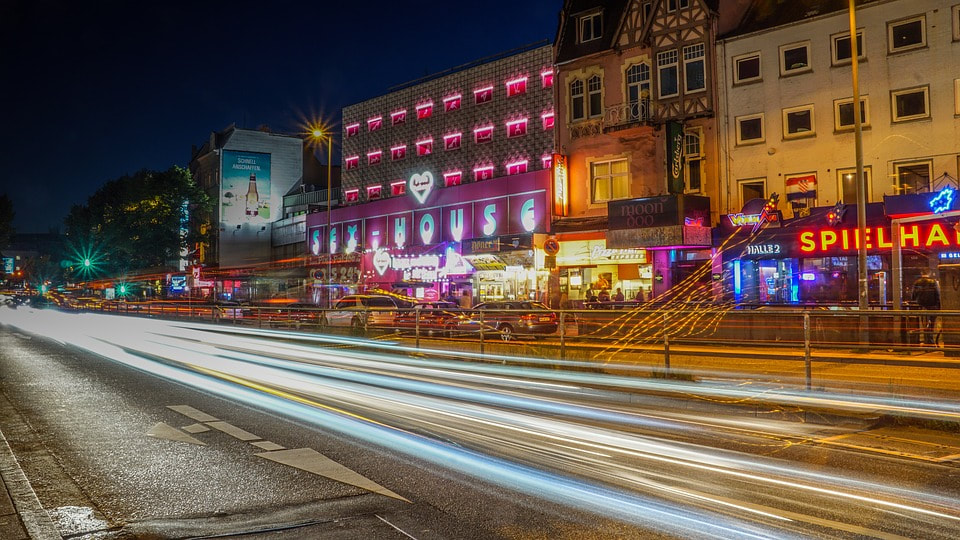I like Hamburg. I didn't find it anymore impressive than other big cities in Germany. Call me weird, but I found the smaller towns and cities more impressive, but hey everyone has their preferences. Hamburg is like a very unique mixed drink. Its a fusion of so many cultures and vibes it's hard to get a grasp of the city's identity.
Hipsters love it for the seedy St. Pauli, reeperbahn and graffiti culture, where fine art junkies marvel at the magnificence of the city's art and cultural scene, and water lovers marvel at the grey skies over the port. Whatever you choose in Hamburg, you're bound to having a good time, rain or shine.
Jungfernsteig
As seen in the above image, Jungfernsteig is a waterfront promenade on the Binnenlaster. On land, explore a myriad of shops and department stores, cafes and independent shops in historical, Neoclassical buildings. The name, Jungfernsteig came about as a tradition of wealthy Hanseaten families who flaunted their unmarried daughters for eligible bachelors.
This warehouse district is a popular place to wander and admire meandering canals, graffiti bridges, historic architecture and locals living their daily life. UNESCO claimed this a world heritage site on July 5, 2015 alongside with the Kontorhaus and Chilehaus displays the largest warehouses in the world. One may consider that the name Chilehaus is a unique name for a German building. And that is true. Built in the 1920's by a local shipping magnate, Henry Sloman, one of the richest in Hamburg, made his fortune trading saltpeter with Chile.
Located in Speicherstadt, this bridge is a hot spot for marvelous photos of the warehouse district. The bridge itself is nothing spectacular besides being pieces of metal floating above water, but most images you see of this district come from the bridge. Sunset is a popular time where the sun reflects off the brick and stone. igniting golden rays of warm hues painted alongside the brick.
One cannot visit an ancient German city without visiting one of the most prominent churches in town. Located in Altstadt, is the city's most famous Baroque church. Built in the 17th Century, the church features a 132-meter dark cupola at the top of the tower, which is visible from any part of town. The church has had its fair share of high and low moments. In 1750, the tower was struck by lightening, causing the tower to fall and crumble. The tower was also damaged by a fire in 1912, and luckily "avoided" extensive damage from World War II. The church's crypt holds the remains of 2,425 bodies including composer Carl Philipp Emanuel Bach. The 106-meter observation deck is open and features a stunning view of the harbor.
Kunsthalle
Nearby the hauptbahnhof (central train station), is one of Germany's most prominent art museums. In my opinion, Berlin has the best, but Hamburg is worth the visit. Explore a mix of fine art and modernism with old and new timer artists such as Rembrandt, Goya and Canelleto, Picasso, Warhol and Kircher.
Sankt Pauli - St. Pauli District & the Reeperbahn
A district where, sin, sex and prostitution thrives, the young and the old come here to "make a party." Alive day and night, there some bouts of normalcy exist with clothing shops, restaurants and art galleries. Although the seediness is controlled, this neighborhood has a history of dancing with the devil. As a port city, sailors have long come to the shores of Hamburg and made way to the St. Pauli District for entertainment after many months at sea. After a consistent amount of time of landlocked mermaids luring sailors of the sea in between the sheets, this is how the red light district originated.
How did you spend a day in Hamburg?
Let's Connect!
This Lemon Tree article is now featured on GPSmyCity. To download this article for offline reading or travel directions to the attractions highlighted in this article, go to How to Spend a Day in Hamburg, Germany.







 RSS Feed
RSS Feed